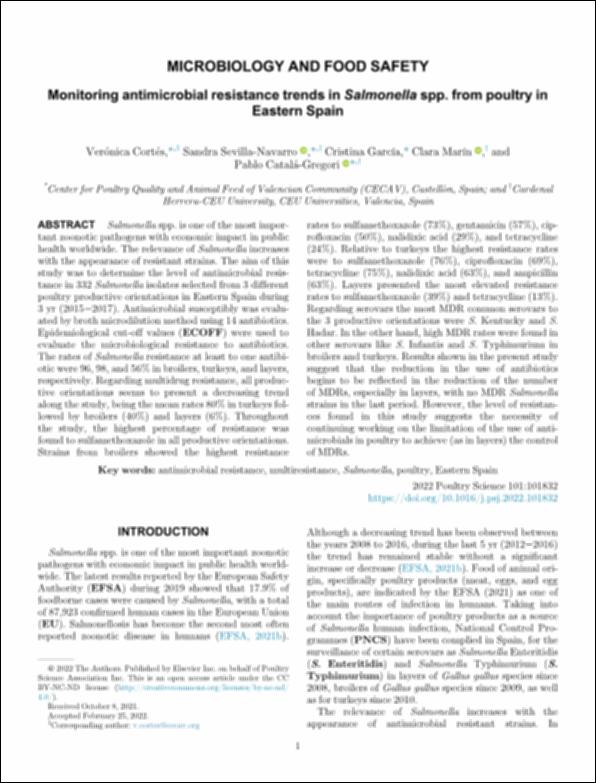Por favor, use este identificador para citar o enlazar este ítem:
http://hdl.handle.net/10637/14260Monitoring antimicrobial resistance trends in "Salmonella" spp. from poultry in Eastern Spain
| Título : | Monitoring antimicrobial resistance trends in "Salmonella" spp. from poultry in Eastern Spain |
| Autor : | Cortés Moñiz, Verónica Sevilla Navarro, Sandra García Bover, Cristina Marín Orenga, Clara Catalá Gregori, Pablo |
| Materias: | Aves de corral - Enfermedades infecciosas.; Poultry - Communicable diseases.; Salmonellosis in animals.; Zoonoses.; Zoonosis.; Bacterias - Resistencia a los medicamentos.; Bacteria - Drug resistance.; Salmonelosis en los animales. |
| Editorial : | Elsevier |
| Citación : | Cortés, V., Sevilla-Navarro, S., García, C., Marín, C. & Catalá-Gregori, P. (2022). Monitoring antimicrobial resistance trends in "Salmonella" spp. from poultry in Eastern Spain. Poultry Science, vol. 101, i. 6 (jun.), art. 101832. DOI: https://doi.org/10.1016/j.psj.2022.101832 |
| Resumen : | Salmonella spp. is one of the most important zoonotic pathogens with economic impact in public health worldwide. The relevance of Salmonella increases with the appearance of resistant strains. The aim of this study was to determine the level of antimicrobial resistance in 332 Salmonella isolates selected from 3 different poultry productive orientations in Eastern Spain during 3 yr (2015−2017). Antimicrobial susceptibly was evaluated by broth microdilution method using 14 antibiotics. Epidemiological cut-off values (ECOFF) were used to evaluate the microbiological resistance to antibiotics. The rates of Salmonella resistance at least to one antibiotic were 96, 98, and 56% in broilers, turkeys, and layers, respectively. Regarding multidrug resistance, all productive orientations seems to present a decreasing trend along the study, being the mean rates 80% in turkeys followed by broilers (40%) and layers (6%). Throughout the study, the highest percentage of resistance was found to sulfamethoxazole in all productive orientations. Strains from broilers showed the highest resistance rates to sulfamethoxazole (73%), gentamicin (57%), ciprofloxacin (50%), nalidixic acid (29%), and tetracycline (24%). Relative to turkeys the highest resistance rates were to sulfamethoxazole (76%), ciprofloxacin (69%), tetracycline (75%), nalidixic acid (63%), and ampicillin (63%). Layers presented the most elevated resistance rates to sulfamethoxazole (39%) and tetracycline (13%). Regarding serovars the most MDR common serovars to the 3 productive orientations were S. Kentucky and S. Hadar. In the other hand, high MDR rates were found in other serovars like S. Infantis and S. Typhimurium in broilers and turkeys. Results shown in the present study suggest that the reduction in the use of antibiotics begins to be reflected in the reduction of the number of MDRs, especially in layers, with no MDR Salmonella strains in the last period. However, the level of resistances found in this study suggests the necessity of continuing working on the limitation of the use of antimicrobials in poultry to achieve (as in layers) the control of MDRs. |
| Descripción : | Este artículo se encuentra disponible en la siguiente URL: https://www.sciencedirect.com/science/article/pii/S0032579122001365 |
| URI : | http://hdl.handle.net/10637/14260 |
| Derechos: | http://creativecommons.org/licenses/by-nc-nd/4.0/deed.es |
| ISSN : | 0032-5791. 1525-3171 (Electrónico) |
| Idioma: | es |
| Fecha de publicación : | 12-jun-2022 |
| Centro : | Universidad Cardenal Herrera-CEU |
| Aparece en las colecciones: | Dpto. Producción y Sanidad Animal, Salud Pública Veterinaria y Ciencia y Tecnología de los Alimentos |
Los ítems de DSpace están protegidos por copyright, con todos los derechos reservados, a menos que se indique lo contrario.


